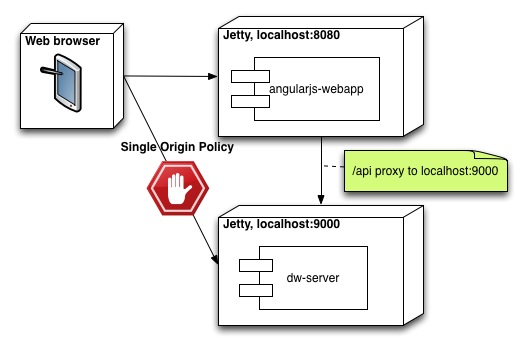This is a little example application that I have used to learn to use the AngularJS and Dropwizard frameworks. It also serves as a project template that can be used to get a new project up and running quickly. A blog article describing what I did can be found here: Getting Started With AngularJS, Jetty and Dropwizard
AngularJS is used to create a simple webapp (angularjs-webapp module), while Dropwizard has been used to create a backend server with RESTful services (dw-server module). The two are deployed on different web servers, as shown here:
- organizing an AngularJS webapp in modules and partials
- AngularJS directives, filters, calling backend services via $resource, etc.
- using Bootstrap with AngularJS
- using $promise returned from $resource calls to ensure that certains functions are executed in sequence
- using Jetty for both the webapp and the backend services
- embedding Jetty in the application in dw-server so that it is very easy to run and debug from the IDE.
- configuring Jetty in the angular-webapp as a proxy to the dw-server in order to tackle the issue that a JavaScript application is not allowed to call back to another server than it's origination server.
- creating RESTful (JSON) services with Jersey & Jackson, including health checks
- getting the services to handle requests from AngularJS $resource
- creating persistence logic with JDBI
- using the the appassembler-maven-plugin to generate a script that will set the classpath and run the webapp
- building fat JARS with Maven Shade Plugin making it possible to deploy Dropwizard services as single .jar files.
- For those with allergies towards xml bloat, there is a gradle (almost) equivalent build.
- Start the dwServer
$projectRoot:> ./gradlew runDwServer - Start the webApp
$projectRoot:> ./gradlew jettyMrun
First time you run ./gradlew it will download a gradle distribution, not install neeeded.
